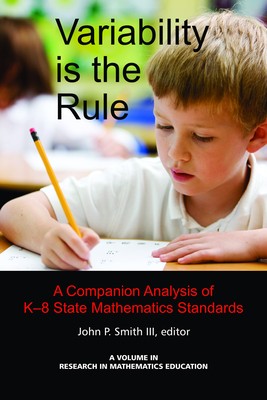
- We will send in 10–14 business days.
- Author: John P Smyth
- Publisher: Information Age Publishing
- ISBN-10: 1617351970
- ISBN-13: 9781617351976
- Format: 15.6 x 23.4 x 1.2 cm, softcover
- Language: English
- SAVE -10% with code: EXTRA
Variability Is the Rule a Companion Analysis of K-8 State Mathematics Standards (e-book) (used book) | bookbook.eu
Reviews
Description
A volume in the series: Research in Mathematics Education. Series Editor(s): Barbara J. Dougherty, Iowa State University In response to No Child Let Behind, states have developed mathematics curriculum frameworks that outline their intended curriculum for grades K-8. While some have indicated that districts or individual schools may use their framework as a model for specific curricular programs, others have taken a more prescriptive or even mandatory stance. Collectively, these frameworks present a sense of the national mathematics program and what we expect students learn. This volume follows The Intended Curriculum as Represented in State Mathematics Curriculum Standards: Consensus or Confusion? (Reys). While the Reys volume focused on number and operations, algebra and reasoning strands, the Smith volume analyzes geometry, measurement, probability, and statistics strands. It also presents an analysis what verbs used tell us about the cognitive demand of grade level expectations. This volume, even more than the Reys volume, emphasizes the theme of variability in the content, expression, and clarity of grade level expectations across the states. As the nation moves toward implementation of the Common Core Standards, this volume highlights some of the challenges teachers and other school personnel face in interpreting mathematics grade-level standards as goals for classroom teaching. The shift from 50 state standards to one document does not resolve this basic challenge.
- Author: John P Smyth
- Publisher: Information Age Publishing
- ISBN-10: 1617351970
- ISBN-13: 9781617351976
- Format: 15.6 x 23.4 x 1.2 cm, softcover
- Language: English English
A volume in the series: Research in Mathematics Education. Series Editor(s): Barbara J. Dougherty, Iowa State University In response to No Child Let Behind, states have developed mathematics curriculum frameworks that outline their intended curriculum for grades K-8. While some have indicated that districts or individual schools may use their framework as a model for specific curricular programs, others have taken a more prescriptive or even mandatory stance. Collectively, these frameworks present a sense of the national mathematics program and what we expect students learn. This volume follows The Intended Curriculum as Represented in State Mathematics Curriculum Standards: Consensus or Confusion? (Reys). While the Reys volume focused on number and operations, algebra and reasoning strands, the Smith volume analyzes geometry, measurement, probability, and statistics strands. It also presents an analysis what verbs used tell us about the cognitive demand of grade level expectations. This volume, even more than the Reys volume, emphasizes the theme of variability in the content, expression, and clarity of grade level expectations across the states. As the nation moves toward implementation of the Common Core Standards, this volume highlights some of the challenges teachers and other school personnel face in interpreting mathematics grade-level standards as goals for classroom teaching. The shift from 50 state standards to one document does not resolve this basic challenge.


Reviews